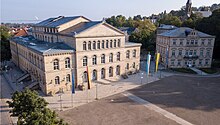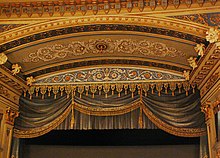Coburg State Theater
The Landestheater Coburg is a medium-sized three-branch theater ( opera / operetta , drama , ballet ) that is jointly supported by the city of Coburg and the Free State of Bavaria . The classicist building on Coburg Castle Square has 480 seats.
history
As the former residence of the Dukes of Saxe-Coburg , Coburg has an old theater tradition. As early as 1630, Duke Johann Casimir gave the first performance of a piece of music by his court conductor Melchior Franck in the Casimirianum grammar school . During the Baroque period, the first Coburg court theater was opened in 1684 under Duke Albrecht . This had its venue for 100 spectators in the upper hall of the armory in Herrengasse. The main contributors were court servants and members of the court society. After Albrecht's death, there were practically no theater performances in Coburg for a long time due to lack of money. It was not until Duke Ernst Friedrich in 1764 that the ballroom, located at today's castle arcades, was converted into a theater. His son Franz Friedrich took care of the theater and engaged various theater groups on their tours through Germany. Mozart operas, pieces by Schiller and Iffland were performed.
After the financial situation of the duchy had improved and the claim to importance had grown due to the expansion to Saxe-Coburg and Gotha , Duke Ernst I founded his own permanent court theater in June 1827, the ducal Saxon court theater in Coburg . The games took place alternately in Coburg or Gotha, in Coburg from September to the beginning of January and in May and June, depending on the stay of the Duke and the court. Together with the redesign of the entire Schlossplatz, Ernst I also planned the construction of a new theater building, which was erected on the site of the steel hut in which the orphanage was housed. The financing of the new building and the expropriation of the orphanage fund led to the theatrical dispute between the Duke and the Coburg state parliament and its dissolution in 1839.
On September 17, 1840, Duchess Marie's birthday , the new theater building was officially opened after three years of construction with the opera Der Feensee by Daniel Auber . Under Duke Ernst II , Wagner operas in particular were fostered at the theater. The Coburg court theater painter Max Brückner was hired by Richard Wagner as a set designer for his festival in Bayreuth . Ernst II also appeared in his theater himself and organized the theater. From 1881 to 1883 the theater had to be temporarily closed due to insufficient funding.
After the resignation of Duke Carl Eduard in 1918, the theater was continued as a theater in Coburg at the expense of the Free State of Coburg . The theater building was finally transferred to the Free State of Coburg from the Duke's private fortune in 1919. The city of Coburg undertook to continue operating under the name Coburgisches Landestheater . Due to the unification of the Free State of Coburg with Bavaria in 1920, Bavaria entered into its obligations. This leads to co-financing (40%) by the Free State of Bavaria, which means that the house, which has been run under the Landestheater Coburg since then , can also be described as the third Bavarian state theater . There was also a guarantee of existence that is still valid today.
building
The design of the multi-part classical building with foyer, hall of mirrors, auditorium with three tiers and stage construction comes from the ducal building inspector Carl Balthasar Harres , a student of Schinkel . The construction was completed in 1838 by the Rudolstadt building officer Vincenz Fischer-Birnbaum. A similar theater building was erected in Gotha at the same time as the Ducal Court Theater (later the Gotha State Theater) . In 1847 the building in Coburg was added to the missing third to the north after demolition of a neighboring building. The theater consists of a three-storey central building with a horseshoe-shaped auditorium and a square stage house under a gently sloping gable roof as well as two-storey side wings for the social and side rooms. In 1857 the middle part of the roof was raised to accommodate additional boxes. The house was last renovated in 1970; the last major renovation of the house and theater technology took place in the years 1970 to 1977.
Upcoming general renovation
Wolfgang Vatke - from 1986 to 2012 administrative director of the Landestheater - already pointed out in 2004 and 2008 the urgent need for renovation of the venue. In October 2011, the cost of the renovation measures was estimated at 26.6 million euros, of which the city of Coburg should take over a quarter. The start of the general renovation was planned for 2013. A water damage on October 30th, 2013 increased the pressure to clean up again considerably. The operating license issued after the water damage was repaired was limited to December 31, 2018. In January 2015, a general agreement was reached between the City of Coburg and the Free State of Bavaria on the general renovation, which is long overdue. The general renovation planned in December 2015, which also includes the nearby Kyrill-Palais , which is also used as an auxiliary theater building , was estimated at a total requirement of 64 million euros. It contained an item for an alternative venue in the amount of up to five million euros. On January 11, 2016, the Coburg City Council approved the financing agreement concluded with the Free State of Bavaria in a special meeting. The state's share of the financing for the general renovation of the main building was set at 75 percent, and for the planned extension to 50 percent.
The selection of the interim venue for the duration of the renovation work, which was not yet specified in the renovation plans, sparked controversial discussions, while the theater could not get any planning security regarding the alternative venue. In February 2016, Mayor Norbert Tessmer indicated that the investment in the Angerturnhalle, which is due to be demolished at the latest after the theater has been used, in the amount of five million euros was difficult to justify in public.
The options for upgrading the Angersporthalle, theater tent, temporary structures such as wooden theaters and various suggestions from project groups from the Coburg University were named for the upcoming decision on the choice of an alternative venue. The duration of the renovation project was estimated at three to four years. The final selection of the alternative venue was postponed in summer 2016; a polygon construction and the upgrading of the Angersporthalle were tendered to a general contractor in parallel. The costs for this were re-estimated at roughly 6.3 to 6.8 million euros; the city council decided an upper limit of 7.5 million euros.
After the approval of a grant for a permanent replacement building in the amount of ten million euros by the Free State of Bavaria and one million euros each by the three largest Coburg companies Brose Fahrzeugteile , HUK Coburg and Kaeser Kompressoren , the Coburg city council decided in early 2018 to build one Replacement venue based on the London Globe Theater .
Theater operations
The big house has 488 seats. Since 1985, plays, chamber operas and chamber music have been performed in the former ducal riding hall on Schlossplatz, which has been converted into a studio stage . In total, the Landestheater Coburg offers around 240 performances per season (33 productions). In the 2017/2018 season, the theater had over 120,000 visitors. In 2008 the theater employed 250 permanent and around 100 part-time employees. The budget in 2013 was 13.6 million euros, the subsidy from the Free State of Bavaria was 5.25 million euros. The basis of the music theater is formed by the Landestheater's choir and the Philharmonic Orchestra, which in addition to the music theater offer several symphony concerts, children's and youth programs and occasional chamber music evenings per season.
Performances
In 1858 the opera Diana von Solange was premiered in the theater by Duke Ernst II . The drama Klaus von Bismarck of Walter Flex was in the autumn of 1913 at the Court Theater premiered in 1978 and the opera Momo and the time thieves by Mark Lothar .
ensemble
Well-known actors and singers who emerged from the Landestheater Coburg are Malvina Schnorr von Carolsfeld , Günter Mack , Klaus Grünberg , Jacqui Bügler , Maud Cunitz , Bettina Feddersen , Simone Mangelsdorff , Gottlob Frick and more recently Susan Anthony , Veronica Ferres , Brigitte Hahn , Franz Hawlata , Julia Koschitz , Christoph Strehl and Roland Wagenführer .
Directors
- 1978–1988: Tebbe Harms Kleen
- 1988–1995: Ernö Weil
- 1995–1996: Karin Heindl-Lau
- 1996–1997: Reinhold Röttger
- 1997–2001: Norbert Kleine-Borgmann
- 2001–2007: Dieter Gackstetter
- 2008–2010: Detlef Altenbeck
- 2010–2017: Bodo Busse
- from 2018: Bernhard F. Loges
General Music Directors
- Albert Bing
- Alfred Ottokar Lorenz (1917–1920)
- Kurt Schröder
- Wilhelm Schönherr (1939–1945)
- Walter Stoschek (1945–1949)
- Helmut Pape
- Reinhard Petersen (1976–1980)
- Paul Theissen (1980–1988)
- Christian Fröhlich (1988–1995)
- Hiroshi Kodama (1996-2001)
- Alois Seidlmeier (2002-2010)
- Roland Kluttig (2010-2020)
- Daniel Carter (from 2021)
Honorary members (selection)
- Nina Bellosa (appointed 1895)
literature
- Harald Bachmann, Jürgen Erdmann (eds.): 150 years of the Coburg State Theater . Landestheater, Coburg 1977, ISBN 3-9800156-0-2
- Paul von Ebart: 100 years of Coburg theater history. 1827-1. June 1927 . (= Coburg local history and local history; Tl 2, H. 3). Roßteuscher, Coburg 1927
- Jürgen Erdmann (Ed.): A theater celebrates. 175 years of the Coburg State Theater . Landestheater, Coburg 2002, ISBN 3-9800156-1-0
- Andrea Heinz: Quantitative game plan research. New possibilities for the writing of theater history using the example of the court theater in Coburg and Gotha (1827-1918) . Winter, Heidelberg 1999, ISBN 3-8253-0786-7 (plus dissertation, University of Erlangen-Nürnberg 1996)
- Hanns-Peter Mederer: The court theaters Meiningen and Coburg-Gotha 1831-1848. Ludwig Bechstein's letters to Friedrich Wilhelm von Kawaczynski . Rockstuhl Verlag Bad Langensalza 2007. ISBN 978-3-938997-75-8
- Peter Morsbach, Otto Titz: City of Coburg. Ensembles - architectural monuments - archaeological monuments . (= Monuments in Bavaria; Volume IV.48). Karl M. Lipp Verlag, Munich 2006, ISBN 3-87490-590-X
Web links
Individual evidence
- ↑ a b c Norbert Klüglein: Millions in the luggage . In: Neue Presse Marktplatz, Coburg edition . February 4, 2016, p. 1 .
- ^ A b Carolin Herrmann: Farewell to the "Mister Landestheater". In: infranken.de. January 7, 2012, accessed October 20, 2016 .
- ↑ a b Jochen Berger: Commitment to the State Theater . In: Coburger Tageblatt . February 2, 2016, p. 11 .
- ↑ Simone Bastian: The audience should feel good . In: Coburger Tageblatt . May 3, 2016, p. 10 .
- ↑ Jochen Berger: Why good sound is not a luxury . In: Coburger Tageblatt . May 13, 2016, p. 16 .
- ↑ Carolin Herrmann: The water comes, the water goes . In: Coburger Tageblatt . May 27, 2016, p. 16 .
- ↑ Simone Bastian: Better a size smaller . In: Coburger Tageblatt . July 23, 2016, p. 9 .
- ↑ Landestheater Coburg: A good season. Retrieved January 24, 2020 .
- ↑ infranken.de, October 1, 2013
- ↑ Contract signed: Dr. Bernhard F. Loges is the new director at the Landestheater Coburg , article in focus from March 16, 2017, accessed on June 13, 2017
- ↑ Ensemble / Behind the Scenes. In: Landestheater Coburg. Accessed December 1, 2019 .
- ↑ Prof. Alois Seidlmeier. In: Karlsruhe University of Music. Accessed December 1, 2019 .
- ^ Daniel Carter becomes General Music Director in Coburg. Retrieved February 26, 2020 .
Coordinates: 50 ° 15 ′ 35 ″ N , 10 ° 58 ′ 1 ″ E




